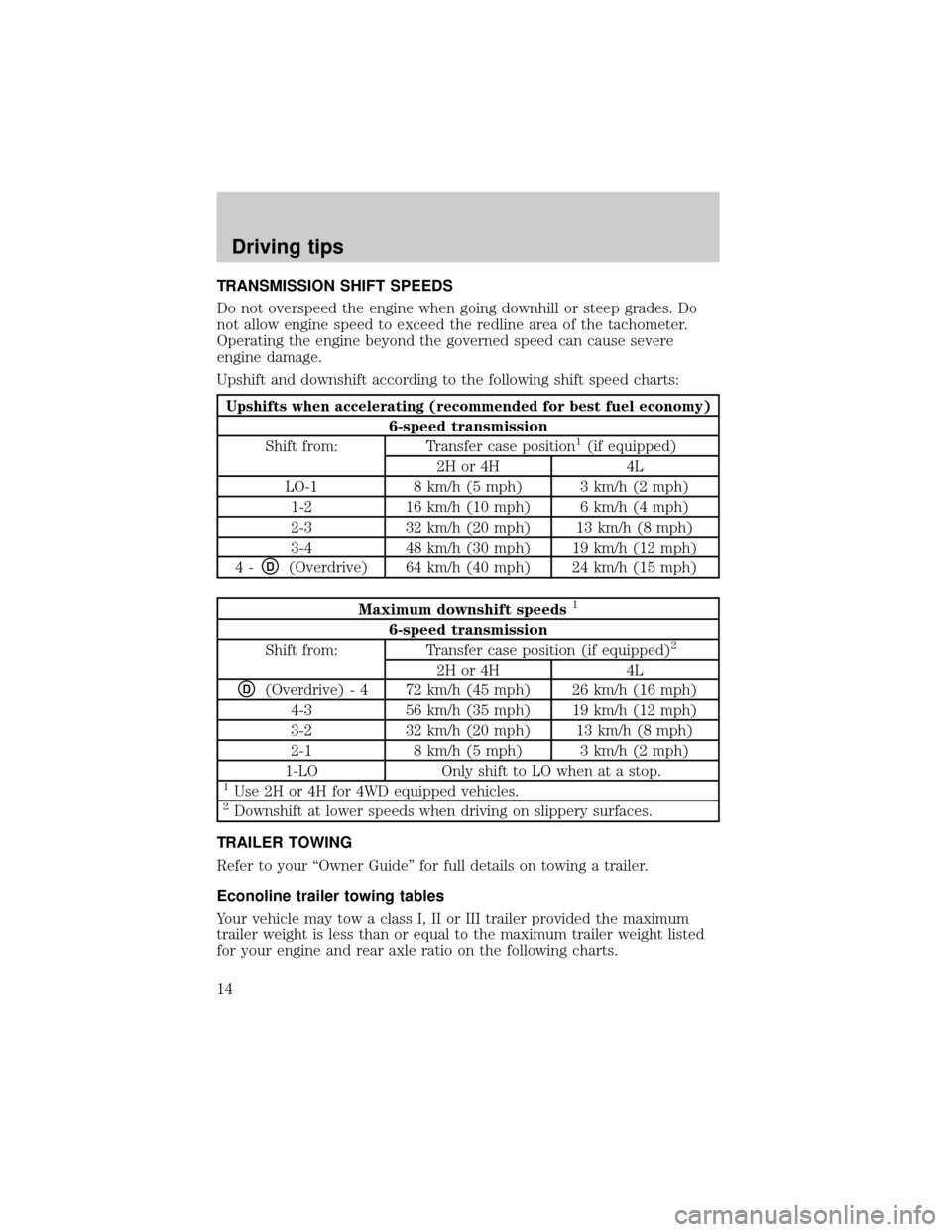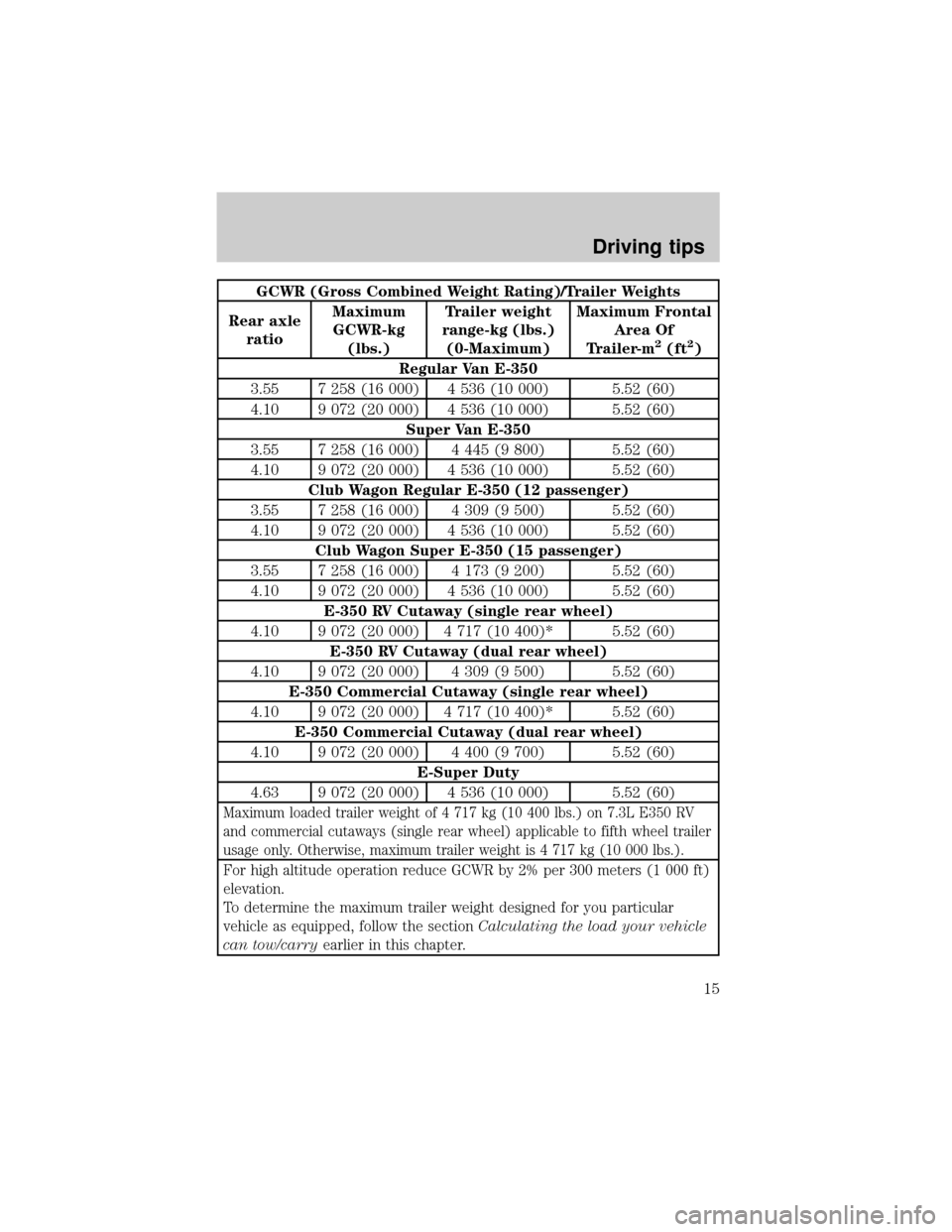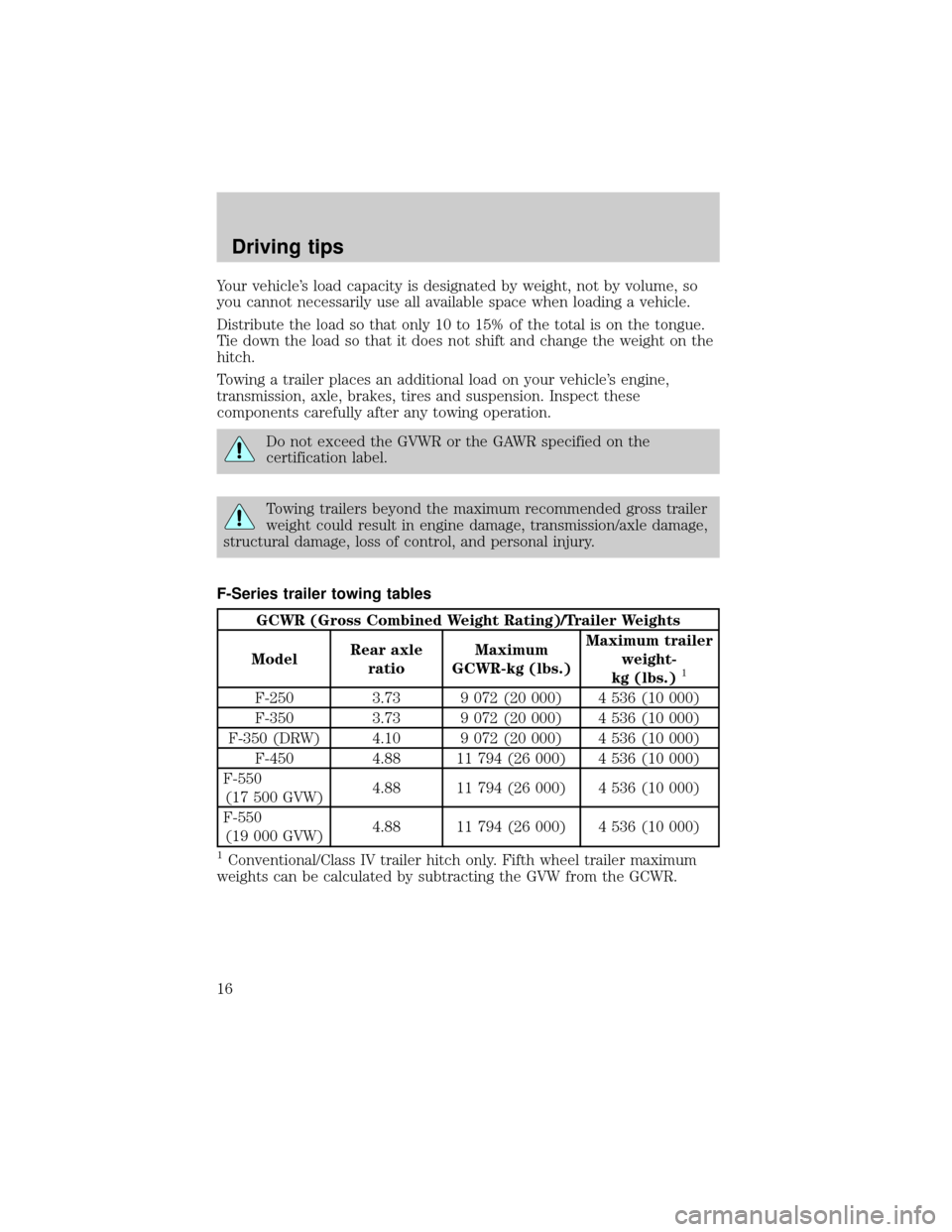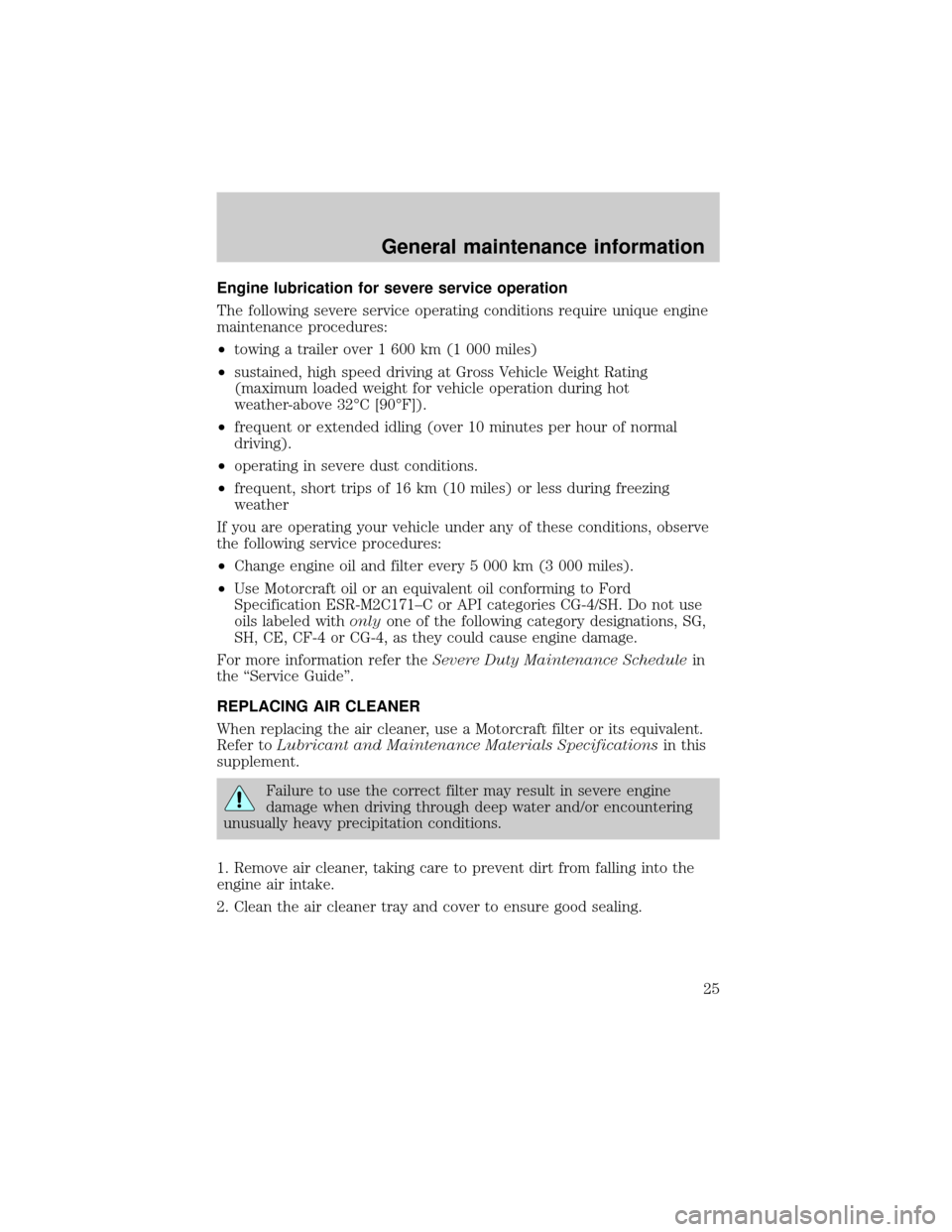1999 FORD E SERIES weight
[x] Cancel search: weightPage 14 of 39

TRANSMISSION SHIFT SPEEDS
Do not overspeed the engine when going downhill or steep grades. Do
not allow engine speed to exceed the redline area of the tachometer.
Operating the engine beyond the governed speed can cause severe
engine damage.
Upshift and downshift according to the following shift speed charts:
Upshifts when accelerating (recommended for best fuel economy)
6-speed transmission
Shift from: Transfer case position1(if equipped)
2H or 4H 4L
LO-1 8 km/h (5 mph) 3 km/h (2 mph)
1-2 16 km/h (10 mph) 6 km/h (4 mph)
2-3 32 km/h (20 mph) 13 km/h (8 mph)
3-4 48 km/h (30 mph) 19 km/h (12 mph)
4-
D(Overdrive) 64 km/h (40 mph) 24 km/h (15 mph)
Maximum downshift speeds1
6-speed transmission
Shift from: Transfer case position (if equipped)2
2H or 4H 4L
D(Overdrive) - 4 72 km/h (45 mph) 26 km/h (16 mph)
4-3 56 km/h (35 mph) 19 km/h (12 mph)
3-2 32 km/h (20 mph) 13 km/h (8 mph)
2-1 8 km/h (5 mph) 3 km/h (2 mph)
1-LO Only shift to LO when at a stop.
1Use 2H or 4H for 4WD equipped vehicles.2Downshift at lower speeds when driving on slippery surfaces.
TRAILER TOWING
Refer to your ªOwner Guideº for full details on towing a trailer.
Econoline trailer towing tables
Your vehicle may tow a class I, II or III trailer provided the maximum
trailer weight is less than or equal to the maximum trailer weight listed
for your engine and rear axle ratio on the following charts.
Driving tips
14
Page 15 of 39

GCWR (Gross Combined Weight Rating)/Trailer Weights
Rear axle
ratioMaximum
GCWR-kg
(lbs.)Trailer weight
range-kg (lbs.)
(0-Maximum)Maximum Frontal
Area Of
Trailer-m
2(ft2)
Regular Van E-350
3.55 7 258 (16 000) 4 536 (10 000) 5.52 (60)
4.10 9 072 (20 000) 4 536 (10 000) 5.52 (60)
Super Van E-350
3.55 7 258 (16 000) 4 445 (9 800) 5.52 (60)
4.10 9 072 (20 000) 4 536 (10 000) 5.52 (60)
Club Wagon Regular E-350 (12 passenger)
3.55 7 258 (16 000) 4 309 (9 500) 5.52 (60)
4.10 9 072 (20 000) 4 536 (10 000) 5.52 (60)
Club Wagon Super E-350 (15 passenger)
3.55 7 258 (16 000) 4 173 (9 200) 5.52 (60)
4.10 9 072 (20 000) 4 536 (10 000) 5.52 (60)
E-350 RV Cutaway (single rear wheel)
4.10 9 072 (20 000) 4 717 (10 400)* 5.52 (60)
E-350 RV Cutaway (dual rear wheel)
4.10 9 072 (20 000) 4 309 (9 500) 5.52 (60)
E-350 Commercial Cutaway (single rear wheel)
4.10 9 072 (20 000) 4 717 (10 400)* 5.52 (60)
E-350 Commercial Cutaway (dual rear wheel)
4.10 9 072 (20 000) 4 400 (9 700) 5.52 (60)
E-Super Duty
4.63 9 072 (20 000) 4 536 (10 000) 5.52 (60)
Maximum loaded trailer weight of 4 717 kg (10 400 lbs.) on 7.3L E350 RV
and commercial cutaways (single rear wheel) applicable to fifth wheel trailer
usage only. Otherwise, maximum trailer weight is 4 717 kg (10 000 lbs.).
For high altitude operation reduce GCWR by 2% per 300 meters (1 000 ft)
elevation.
To determine the maximum trailer weight designed for you particular
vehicle as equipped, follow the sectionCalculating the load your vehicle
can tow/carryearlier in this chapter.
Driving tips
15
Page 16 of 39

Your vehicle's load capacity is designated by weight, not by volume, so
you cannot necessarily use all available space when loading a vehicle.
Distribute the load so that only 10 to 15% of the total is on the tongue.
Tie down the load so that it does not shift and change the weight on the
hitch.
Towing a trailer places an additional load on your vehicle's engine,
transmission, axle, brakes, tires and suspension. Inspect these
components carefully after any towing operation.
Do not exceed the GVWR or the GAWR specified on the
certification label.
Towing trailers beyond the maximum recommended gross trailer
weight could result in engine damage, transmission/axle damage,
structural damage, loss of control, and personal injury.
F-Series trailer towing tables
GCWR (Gross Combined Weight Rating)/Trailer Weights
ModelRear axle
ratioMaximum
GCWR-kg (lbs.)Maximum trailer
weight-
kg (lbs.)
1
F-250 3.73 9 072 (20 000) 4 536 (10 000)
F-350 3.73 9 072 (20 000) 4 536 (10 000)
F-350 (DRW) 4.10 9 072 (20 000) 4 536 (10 000)
F-450 4.88 11 794 (26 000) 4 536 (10 000)
F-550
(17 500 GVW)4.88 11 794 (26 000) 4 536 (10 000)
F-550
(19 000 GVW)4.88 11 794 (26 000) 4 536 (10 000)
1Conventional/Class IV trailer hitch only. Fifth wheel trailer maximum
weights can be calculated by subtracting the GVW from the GCWR.
Driving tips
16
Page 25 of 39

Engine lubrication for severe service operation
The following severe service operating conditions require unique engine
maintenance procedures:
²towing a trailer over 1 600 km (1 000 miles)
²sustained, high speed driving at Gross Vehicle Weight Rating
(maximum loaded weight for vehicle operation during hot
weather-above 32ÉC [90ÉF]).
²frequent or extended idling (over 10 minutes per hour of normal
driving).
²operating in severe dust conditions.
²frequent, short trips of 16 km (10 miles) or less during freezing
weather
If you are operating your vehicle under any of these conditions, observe
the following service procedures:
²Change engine oil and filter every 5 000 km (3 000 miles).
²Use Motorcraft oil or an equivalent oil conforming to Ford
Specification ESR-M2C171±C or API categories CG-4/SH. Do not use
oils labeled withonlyone of the following category designations, SG,
SH, CE, CF-4 or CG-4, as they could cause engine damage.
For more information refer theSevere Duty Maintenance Schedulein
the ªService Guideº.
REPLACING AIR CLEANER
When replacing the air cleaner, use a Motorcraft filter or its equivalent.
Refer toLubricant and Maintenance Materials Specificationsin this
supplement.
Failure to use the correct filter may result in severe engine
damage when driving through deep water and/or encountering
unusually heavy precipitation conditions.
1. Remove air cleaner, taking care to prevent dirt from falling into the
engine air intake.
2. Clean the air cleaner tray and cover to ensure good sealing.
General maintenance information
25
Page 30 of 39

This additive aids in the prevention of rust and scale buildup on the
internal parts of the cooling system. Prevention of rust and scale buildup
allows for proper dissipation of heat generated by combustion.
See the ªService Guideº for recommended intervals.
EMISSION CONTROL SYSTEM(S) LAWS
Federal law prohibits vehicle manufacturers, dealers and other persons
engaged in the business of repairing, servicing, selling, leasing or trading
motor vehicles as well as fleet operations from unknowingly removing or
rendering emission control system(s) inoperative. Further, modifications
of the emission control system(s) could create liability on the part of the
individual owners under the laws of some states. In Canada,
modifications of the emission control system(s) could create liability
under applicable Federal or Provincial laws.
Do not remove or alter the original equipment floor covering or
insulation between it and the metal floor of the vehicle. The floor
covering and insulation protect occupants of the vehicle from the engine
and exhaust system heat and noise. On vehicles with no original
equipment floor covering insulation, do not carry passengers in a manner
that permits prolonged skin contact with the metal floor. Provide
adequate insulation.
NOISE EMISSIONS WARRANTY, PROHIBITED TAMPERING ACTS
AND MAINTENANCE
On January 1, 1978, Federal regulation became effective governing the
noise emission on trucks over 4 536 kg (10 000 lbs.) GVWR (Gross
Vehicle Weight Rating). The following statements concerning prohibited
tampering acts and maintenance, and the noise warranty found in the
Warranty Facts Booklet, are applicable to complete chassis cabs over
4 536 (10 000 lbs.) GVWR.
Tampering with noise control system prohibited
Federal law prohibits the following acts or the causing thereof: (1) The
removal or rendering inoperative by any person other than for purposes
of maintenance, repair or replacement of any device or element of design
incorporated into any new vehicle for the purpose of noise control prior
to its sale or delivery to the ultimate purchaser or while it is in use, or
(2) the use of the vehicle after such device or element of design has
been removed or rendered inoperative by any person.
General maintenance information
30